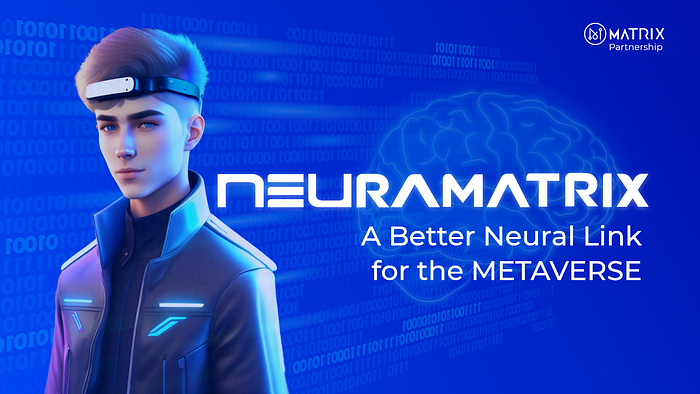NeuraMatrix - A Better Neural Link for the Metaverse

On August 3rd, 2020, the SpaceX Crew Dragon successfully landed in the Atlantic Ocean. This first successful manned flight mission marks a milestone for the commercial space travel industry and writes a new chapter of glory in the legacy of the Silicon Valley Iron Man, Elon Musk.

SpaceX is one of the many star companies led by Elon Musk, including SpaceX, Tesla, the Boring Company, Hyperloop, SolarCity, and last but not least NeuraLink, a company specialising in brain-computer interface.
But even as NeuraLink is catching all the attention and spotlight, on the other side of the globe, NeuraMatrix, a BCI project in the Matrix ecosystem is quietly rising. According to NeuraMatrix’s founder Milin, NeuraMatrix is the only company that can compete with NeuraLink in the Chinese market. Compared to the prototype previously released by Musk, NeuraMatrix’s prototype has better anti-noise features and can carry out unlimited external interactions as well as information exchange with the internal nervous system. As we see, Milin does not hide his confidence in NeuralMatrix’s technology and products.
So how do NeuraMatrix and NeuraLink compare?
What is BCI? What is the BCI industry like?
According to Wikipedia, BCI (or brain-computer interface) refers to a direct unidirectional/bidirectional pathway created between a brain (or a brain cell culture) and an external device. In the case of a unidirectional interface, a computer either receives commands from the brain or sends signals to the brain, but cannot send and receive signals simultaneously. A bidirectional interface allows for two-way information exchange between the brain and the computer.
Research on BCI has a history of over 30 years. Since the mid-1990s, breakthroughs are happening at a faster rate in this field. Through years of animal experiments, researchers have designed and manufactured early implantable devices for the human body, which can be used to restore impaired auditory, visual, or motor functions. The exceptional adaptability of the cerebral cortex allows the brain to sync with BCI to control implanted prosthetics like natural limbs.
Over time, researchers have also created BCIs for enhancing the functions of the human body rather than restoring them.

BCI can be divided into invasive, partially invasive, and non-invasive interfaces. Invasive interfaces require sensors to be implanted into the brain tissue to obtain neural electrical signals. It usually requires invasive surgery that penetrates deep into the cerebral cortex. Partially invasive interfaces generally involve placing sensors on the surface of the cerebral cortex inside the cranial cavity between the scalp and the cerebral cortex. Non-invasive devices are only placed on the surface of the scalp to collect signals.
Overall, the deeper the invasion, the better quality signal can be collected. But there is also more risk involved.
As we know, NeuraLink, founded in 2016, has adopted the invasive approach. As its competitor, NeuraMatrix has chosen the same.
The Development and Achievements of NeuraLink
In July 2019, at a presentation at the California Academy of Sciences, Musk publicly stated that NeuraLink had found an efficient method for BCI: using a neurosurgical robot to directly implant into the human brain proprietary chips and information strips known as “threads”, which can then be read via a USB-C interface and controlled using an app on an iPhone. NeuraLink had already started experiments on mice, where they were able to read information from 1,500 electrodes. Musk also mentioned that in collaboration with the University of California, a monkey was able to operate a computer using its brain.

NeuraLink’s president Max Hodak also stated that NeuraLink will seek FDA’s approval and begin human clinical trials as early as 2020.
On July 16, 2019, American tech website Futurism reported NeuraLink’s first breakthrough with flexible electrode threads. These threads are about 4–6 micrometers wide, and compared to materials previously used in the industry, they are less likely to cause damage to the brain. At present, surgical doctors still need to drill holes in the skull, but in the future, they hope to use a laser beam to make a series of microscopic holes. On the following day, the New York Times wrote, “the core technologies of NeuraLink’s BCI device are electrode threads, implantation robots, and brain signal reading chips.”
NeuraLink claimed to have developed a custom chip that can better read, clean, and amplify brain signals. The chip connects to the brain through the aforementioned electrode wires, with each bundle consisting of 1024 threads wirelessly connected to a device behind one’s ears that is wearable, detachable and upgradable and can interact wirelessly with a phone. In early July 2020, Musk announced on Twitter that NeuraLink would reveal its latest progress on August 28th. It was expected that NeuraLink would introduce some of the latest advances in neurotechnology at the event. On July 20th, Musk replied to a question from computer scientist Austin Howard on Twitter. Austin asked, “Can people use NeuraLink to listen to music from a chip?” Musk’s answer was yes!
The Matrix AI Network was founded in 2017. In 2023, we enter Matrix 3.0 blending neuroscience with our previous work to realize the vision of the Matrix films.
FOLLOW MATRIX:
Website | GitHub | Twitter | YouTube
Telegram (Official) | Telegram (Masternodes)
Owen Tao (CEO) | Steve Deng (Chief AI Scientist) | Eric Choy (CMTO)
